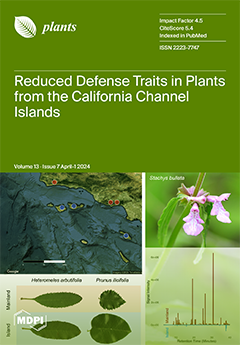Winter sprouting potential and red rot resistance are two key parameters for successful sugarcane breeding in the subtropics. However, the cultivated sugarcane hybrids had a narrow genetic base; hence, the present study was planned to evaluate the
Erianthus procerus genome introgressed Saccharum hybrids for their ratooning potential under subtropical climates and red rot tolerance under tropical and subtropical climates. A set of 15
Erianthus procerus derived hybrids confirmed through the
5S rDNA marker, along with five check varieties, were evaluated for agro-morphological, quality, and physiological traits for two years (2018–2019 and 2019–2020) and winter sprouting potential for three years (2018–2019, 2019–2020, and 2020–2021). The experimental material was also tested against the most prevalent isolates of the red rot pathogen in tropical (
Cf671 and
Cf671 +
Cf9401) and subtropical regions (
Cf08 and
Cf09). The
E. procerus hybrid GU 12—19 had the highest winter sprouting potential, with a winter sprouting index (WSI) of 10.6, followed by GU 12—22 with a WSI of 8.5. The other top-performing hybrids were as follows: GU 12—21 and GU 12—29 with a WSI of 7.2 and 6.9, respectively. A set of nine
E. procerus-derived hybrids, i.e., GU04 (28) EO—2, GU12—19, GU12—21, GU12—22, GU12—23, GU12—26, GU12—27, GU12—30, and GU12—31, were resistant to the most prevalent isolates of red rot in both tropical and subtropical conditions. The association analysis revealed significant correlations between the various traits, particularly the fibre content, with a maximum number of associations, which indicates its multifaceted impact on sugarcane characteristics. Principal component analysis (PCA) summarised the data, explaining 57.6% of the total variation for the measured traits and genotypes, providing valuable insights into the performance and characteristics of the
Erianthus procerus derived hybrids under subtropical climates. The anthocyanin content of
Erianthus procerus hybrids was better than the check varieties, ranging from 0.123 to 0.179 (2018–2019) and 0.111 to 0.172 (2019–2020); anthocyanin plays a vital role in mitigating cold injury, acting as an antioxidant in cool weather conditions, particularly in sugarcane. Seven hybrids recorded a more than 22% fibre threshold, indicating their industrial potential. These hybrids could serve as potential donors for cold tolerance and a high ratooning ability, along with red rot resistance, under subtropical climates.
Full article






